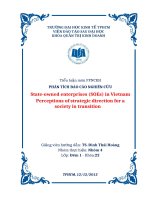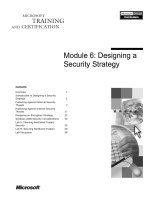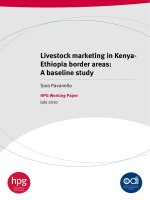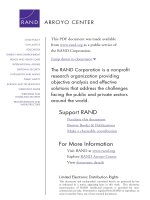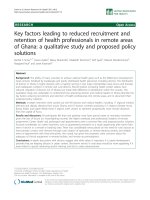Assuring Access in Key Strategic Regions - Toward a Long-Term Strategy docx
Bạn đang xem bản rút gọn của tài liệu. Xem và tải ngay bản đầy đủ của tài liệu tại đây (858.99 KB, 187 trang )
This PDF document was made available
from
www.rand.org as a public service of
the RAND Corporation.
6
Jump down to document
Visit RAND at www.rand.org
Explore RAND Arroyo Center
View document details
This document and trademark(s) contained herein are protected by law
as indicated in a notice appearing later in this work. This electronic
representation of RAND intellectual property is provided for non-
commercial use only. Permission is required from RAND to reproduce, or
reuse in another form, any of our research documents.
Limited Electronic Distribution Rights
For More Information
CHILD POLICY
CIVIL JUSTICE
EDUCATIO
N
ENERGY AND ENVIRONMENT
HEALTH AND HEALTH CAR
E
INTERNATIONAL AFFAIR
S
NATIONAL SECURIT
Y
POPULATION AND AGIN
G
PUBLIC SAFETY
SCIENCE AND TECHNOLOGY
SUBSTANCE ABUSE
TERRORISM AND
HOMELAND SECURITY
TRANSPORTATION AND
INFRASTRUCTURE
The RAND Corporation is a nonprofit
research organization providing
objective analysis and effective
solutions that address the challenges
facing the public and private sectors
around the world.
Purchase this document
Browse Books & Publications
Make a charitable contribution
Support RAND
This product is part of the RAND Corporation monograph series.
RAND monographs present major research findings that address the
challenges facing the public and private sectors. All RAND mono
-
graphs undergo rigorous peer review to ensure high standards for
research quality and objectivity.
Prepared for the United States Army
Approved for public release, distribution unlimited
ERIC V. LARSON, DEREK EATON, PAUL ELRICK,
THEODORE KARASIK, ROBERT KLEIN, SHERRILL LINGEL,
BRIAN NICHIPORUK, ROBERT UY, JOHN ZAVADIL
Assuring Access in
Key Strategic Regions
Toward a Long-Term Strategy
The RAND Corporation is a nonprofit research organization providing
objective analysis and effective solutions that address the challenges
facing the public and private sectors around the world. RAND’s
publications do not necessarily reflect the opinions of its research clients
and sponsors.
R
®
is a registered trademark.
© Copyright 2004 RAND Corporation
All rights reserved. No part of this book may be reproduced in any form
by any electronic or mechanical means (including photocopying,
recording, or information storage and retrieval) without permission in
writing from RAND.
Published 2004 by the RAND Corporation
1700 Main Street, P.O. Box 2138, Santa Monica, CA 90407-2138
1200 South Hayes Street, Arlington, VA 22202-5050
201 North Craig Street, Suite 202, Pittsburgh, PA 15213-1516
RAND URL: />To order RAND documents or to obtain additional information, contact
Distribution Services: Telephone: (310) 451-7002;
Fax: (310) 451-6915; Email:
Library of Congress Cataloging-in-Publication Data
Assuring Access in Key Strategic Regions : Toward a Long Term Strategy / Eric V. Larson
[et al.].
p. cm.
Includes bibliographical references.
“MG-112.”
ISBN 0-8330-3544-4 (pbk.)
1. Deployment (Strategy) 2. United States. Army. 3. Military doctrine—United
States. 4. Operational art (Military science) 5. World politics—21st century.
6. Asymmetric warfare. I. Larson, Eric V. (Eric Victor), 1957–
U163.T68 2004
355.4'773—dc22
2004000101
The research described in this report was sponsored by the United States
Army under Contract No. DASW01-01-C-0003.
iii
Preface
This is the final report of a Fiscal Year 2002 study for the U.S. Army
Deputy Chief of Staff for Operations (G-3), titled “Anti-Anti-Access:
Ensuring Regional Access for Future U.S. Land Forces,” which
examined potential adversaries’ anti-access strategies and potential
U.S. counters to these strategies.
The purpose of the study was twofold. First, it aimed to support
the Army’s development of transformed land forces by identifying
access requirements, potential anti-access threats and counters, and
coalition/alliance dependencies during the 2003–2012 time period.
This time frame was chosen because it is the focus of current Army
planning and because it is nearly impossible to have much certainty
about potential adversary capabilities beyond that period. Second, it
considers operational and technical means for overcoming anti-access
threats. This report summarizes the main findings of the study; some
unpublished research about the study has also been done, including
the following titles:
• “Anti-Access in a Baltic Scenario,” 2003;
• “Anti-Access in a SWA Scenario,” 2003;
• “Anti-Access in a PRC-Taiwan Scenario,” 2003; and
• “Anti-Access Strategies: A Quantitative Analysis of Military
Methods for Preventing, Delaying, and Degrading U.S. Force
Buildups,” 2003.
iv Assuring Access in Key Strategic Regions: Toward a Long-Term Strategy
The project was sponsored by the Office of the Deputy Chief of
Staff G-3 (Operations and Plans), U.S. Army. The project was con-
ducted in the Strategy, Doctrine, and Resources Program of the
RAND Arroyo Center. The Arroyo Center is a federally funded
research and development center sponsored by the U.S. Army.
For more information on RAND Arroyo Center, contact the
Director of Operations (telephone 310-393-0411, extension 6419;
FAX 310-451-6952; e-mail ), or visit
Arroyo’s web site at />v
Contents
Preface iii
Figures and Tables
ix
Summary
xi
Acknowledgments
xxi
Glossary
xxiii
CHAPTER ONE
Introduction 1
Organization of This Report
4
CHAPTER TWO
Analytic Approach 7
Some Conceptual Building Blocks
7
A Definition for Anti-Access Strategies
8
The Access Game
8
A Stylized Representation of a Deployment
12
Characterization of Potential Anti-Access Vulnerabilities
13
Quantitative Analysis of Military Utility
14
Seminar-Style Gaming
15
CHAPTER THREE
Southwest Asian Theater: An Iraq Game 19
Overview of the Game
19
The Scenario
20
Actors, Objectives, CONOPs, and Capabilities
22
vi Assuring Access in Key Strategic Regions: Toward a Long-Term Strategy
Findings 26
Key Access Issues
26
Threats of Greatest Concern
30
Other Threats Considered
34
Implications for Regional Commanders
34
Access Requirements
34
Options for Commander, CENTCOM
38
CHAPTER FOUR
The Pacific Theater: A PRC-Taiwan Game 43
Overview of the Game
43
The Scenario
44
Actors, Objectives, CONOPs, and Capabilities
44
Findings
50
Key Access Issues
51
Threats of Greatest Concern
53
Other Threats Considered
57
Implications for Regional Commanders
58
Access Requirements
59
Options for the PACOM Commander
61
CHAPTER FIVE
European Theater: A Russia-Baltics Game 65
Overview of the Game
65
The Scenario
65
Actors, Objectives, CONOPs, and Capabilities
68
Findings
72
Key Access Issues
72
Threats of Greatest Concern
75
Other Threats Considered
79
Implications for Regional Commanders
82
Access Requirements
82
Options for the Commander of EUCOM
84
CHAPTER SIX
Latin America and the Caribbean 87
Contents vii
Overview of the Games 87
The Scenarios
88
Potential Adversaries in Latin America and the Caribbean
88
Indigenous Guerrilla and Terrorist Groups
89
Nonindigenous Guerrilla and Terrorist Groups
90
Regional Conventional Militaries
91
Findings
92
Threats of Greatest Concern
93
Implications for Regional Commanders
94
Access Requirements
94
Options for the Commander of SOUTHCOM
95
CHAPTER SEVEN
What the Games Revealed About Anti-Access Threats 97
Anti-Access Threats of Greatest Concern
100
Ballistic and Cruise Missiles: A Threat to Bases, Leaders,
and Populations
101
Extended-Range Surface-to-Air Missiles: A Threat to Air
Mobility
104
Antiship Missiles, Attack Submarines, and Sea Mining:
Threats to Sealift
105
Wild-Card Capabilities
107
CHAPTER EIGHT
Toward a Strategy for Assuring Access 115
Peacetime Activities
117
Assuring Partners and Allies
118
Deterring Adversaries
119
Maintaining and Developing New Options
120
Investments in Self-Defense by U.S. Partners and Allies
126
Crisis and Wartime Activities
126
Deploying and Defending
127
Improving, Seizing, or Building Access
127
Protecting Forces and Bases of Operation
128
The Question of Costs
129
viii Assuring Access in Key Strategic Regions: Toward a Long-Term Strategy
CHAPTER NINE
Conclusions and Implications 131
Implications for Intelligence Needs
131
Strategic Intelligence
131
Operational Military Intelligence
133
Technical Intelligence
134
Commercial Intelligence
135
Implications for Transformation Management
136
Bibliography
141
ix
Figures and Tables
Figures
2.1. Overview of the Access Game 9
2.2. The Adversary’s Adaptive Strategy for the Access Game
11
2.3. U.S. Adaptive Strategy for the Access Game
11
2.4. A Stylized Representation of a Deployment
13
3.1. Sea Routes for a Deployment to the Kuwait Theater
of Operations
29
8.1. A Strategy for Assuring Access
116
Tables
2.1. Classification of Anti-Access Targets 14
2.2. Preferred Means of Attacking Anti-Access Target Classes
15
xi
Summary
Since the end of the Cold War, agreement within the defense com-
munity that the United States must be able to project power abroad
quickly and effectively has been increasing. From the 1990 Base
Force’s emphasis on forward presence and crisis response to the 1997
Quadrennial Defense Review’s strategic tenets of “shape and
respond,” U.S. defense planning has envisioned the reinforcement of
in-theater forces.
1
The most recent (September 2001) Quadrennial
Defense Review (QDR) gave increased emphasis to deployability,
operations in anti-access environments, and protecting bases of opera-
tion at home and abroad.
2
Even as the Army transforms its forces to be more deployable,
however, U.S. adversaries continue to develop asymmetric strategies
and means, among which we would include efforts to complicate
U.S. access to a theater of operation—adversary anti-access strategies.
Adversary anti-access strategies can be defined in a very broad way; in
our conception, these are strategies
_____________
1
Following publication of the 1997 QDR, the December 1997 report of the National
Defense Panel identified access issues as an area of key concern. See National Defense Panel,
Transforming Defense: National Security in the 21st Century, Washington, D.C., December
1997.
2
The 2001 QDR states that “projecting and sustaining U.S. forces in distant anti-access or
area-denial environments and defeating anti-access and area-denial threats” is one of the
Department of Defense’s (DoD’s) six operational goals driving transformation of the force.
xii Assuring Access in Key Strategic Regions: Toward a Long-Term Strategy
• “whose aim is to deter, prevent, degrade, disrupt, delay, or
otherwise complicate the mobilization, deployment, entry, and
buildup of U.S. forces for military operations in a theater;
• “that can be executed during peacetime, in crisis, and in conflict
and that can involve strategic, operational, and/or tactical
methods (strategic methods can include military, diplomatic,
political, economic, psychological, and other measures whose
effects transform the nature of the conflict; operational methods
can include actions that force the United States to operate from
a greater than preferred range; and tactical methods can include
conventional and unconventional capabilities that can hinder
deployment and onward movement);
• “that may involve actions against continental U.S. (CONUS),
en-route, or in-theater targets;
• “that may be integrated with broader national strategies to
include actions that are executed during peacetime, crisis, and
conflict; and
• “that may involve actions taken either by an adversary or by its
proxies.
In the context of the Army’s ongoing transformation efforts, it is
difficult in the abstract to determine the level of threat posed by the
growing repertoire of anti-access tools that potential adversaries may
have available in the near- and longer-term future. This report aims
to make the anti-access threat more tangible by assessing the efficacy
of anti-access strategies—and U.S. and coalition counters—in a small
but diverse set of conflict scenarios.
Defining the Access Game
In exploring these scenarios, the study team made efforts to examine
how the character of the competition between the United States and
a potential adversary might evolve in peacetime, crisis, and war and
what this might imply for U.S. strategy and force development. This
work gave rise to a construct we called “the access game,” in which
Summary xiii
the United States and a potential regional adversary would, through
trial and error, seek to shape the future access outlook for the United
States.
The access game envisions that during peacetime the adversary
will seek to deter both U.S. involvement in the region and regional
cooperation with the United States. It also foresees adversary efforts
to shape the U.S. access environment by coercing U.S. regional part-
ners and allies to withhold access. As the situation moves from peace-
time to crisis and war, the adversary may use a variety of political,
economic, and military means to, first, prevent the United States
from gaining access and, failing that, to delay or degrade the buildup
and onward movement of U.S. forces.
Meanwhile, in peacetime, the United States will seek to assure
partners and allies in handling internal and external threats to their
security while deterring the adversary, and preempting and counter-
ing its peacetime maneuvering to restrict or otherwise shape the U.S.
access outlook. As the situation moves to crisis and war, the U.S. aim
will shift to mitigating or overcoming adversary actions to prevent,
delay, or degrade the buildup of U.S. forces. For each of the scenarios
the study team examined in seminar gaming, we considered the
nature of the peacetime, crisis, and wartime actions that might be
taken by the United States and its putative adversary and what key
challenges and opportunities might present themselves.
Findings
Findings from Scenario Gaming
Our consideration of the access game in the context of the scenarios
led us to conclude that, while adversary anti-access strategies are not
the only strategies available and others, such as strategies of annihila-
tion and attrition, also need to be considered, we believe that the
anti-access threat is a serious and growing one. To reduce U.S. vul-
nerability to adversary anti-access strategies, the Army and DoD
should pursue a range of options that would improve the access-
enhancing characteristics of U.S. forces. These options include
xiv Assuring Access in Key Strategic Regions: Toward a Long-Term Strategy
• further diversifying the U.S. portfolio of prospective bases and
mobility capabilities while reducing their requirements for
mature infrastructure;
• improving the self-deployability of some forces to underwrite
new deployment concepts and warfighting concepts; and
• ensuring capabilities for rapidly assaulting, seizing, and improv-
ing bases to make them suitable for the conduct of operations.
The conflict scenarios used in the study were designed with the
aim of illuminating anti-access strategies and threats in peacetime,
crisis, and war in four geographic areas of responsibility—European,
Pacific, Central, and Southern Command. The scenarios featured
adversaries at the high end of the capability scale in each region—i.e.,
those who would be expected to have recourse to the most potent and
diverse portfolio of anti-access strategies and capabilities. Occasion-
ally, the scenarios sacrificed detail in areas that seemed less relevant to
access issues to better illuminate the character of potential access
challenges.
We explored anti-access in a Southwest Asia scenario in which
Iraq was assumed to be months away from acquiring a nuclear
weapon. We also examined an East Asia scenario in which the Peo-
ple’s Republic of China sought to resolve the issue of Taiwan’s status
through military means. We also analyzed a European scenario in
which Russia undertook an attack on the Baltic states under the guise
of protecting Russian minorities. Finally, we considered in somewhat
less detail a range of less-than-war operations in Central and South
America.
While our assessments of these scenarios led to a reasonably san-
guine view of U.S. ability to prevail in each, a number of threats were
cause for concern. These will be discussed next.
Adversary Actions Taken for Strategic Political or Psycho-
logical Impact Are Likely to Prove Most Successful. Our principal
findings from the scenario analyses were as follows:
Summary xv
• Because their weapon systems are likely to lack range, accuracy,
and payload during the 2003–2012 period we examined,
adversaries are likely to have more incentives to use anti-access
military capabilities against regional leadership, population, and
high-profile soft military targets rather than attempting to
destroy a whole set of bases or other anti-access targets.
Moreover, nonmilitary means (cooptation, coercion, subversion,
information operations, and psychological operations) may in
fact prove to be more effective than military means in achieving
anti-access objectives.
• For the same reason, attacks on bases and other infrastructure
are more likely to prove successful for their psychological
value—raising the costs of a military action in the hope of get-
ting policymakers to reconsider—than the military significance
of what they can reliably destroy.
• Control of chokepoints, while likely to be short-lived, can have
important operational impacts on the role of land forces and on
campaign outcomes and measures of effectiveness.
• Most adversaries presently lack strategic reach except through
special operations forces or terrorist proxies and therefore appear
to have limited opportunities to conduct anti-access attacks out-
side of their immediate theater of operation. Nevertheless,
important “wild cards” exist, such as longer-range ballistic mis-
siles with nuclear warheads, that should not be entirely ruled
out.
• Technological trends are such that anti-access capabilities could
substantially improve beyond the 2012 horizon we examined.
The United States needs to anticipate these trends and begin to
take measures now that would prevent potential adversaries
from achieving any new, decisive anti-access capabilities. The
proliferation of nuclear weapons, highly accurate ballistic and
cruise missiles, or advanced SAMs would be particularly
worrisome.
Our analysis of these scenarios suggested that greater concern is
warranted for actions that might be taken for strategic political or
xvi Assuring Access in Key Strategic Regions: Toward a Long-Term Strategy
psychological impact than for those that are strictly military in
nature. In particular, adversaries seemed to have a wide variety of
nonmilitary carrots and sticks that they might employ to complicate
or restrict the U.S. access outlook in a region, and in many ways these
were more worrisome than the military methods. In several of the
scenarios, the study team saw great potential for psychological opera-
tions and propaganda as a tool for imposing costs on regional part-
ners and allies for their cooperation with the United States. This was
especially acute in the Southwest Asia scenario, where Iraq cynically
sought to link its own situation to the Palestinian issue in the minds
of regional Arab and Muslim populations and to erode support for
the United States by highlighting its continued support for Israel. It
also played in the Baltics scenario, where Russia’s claims that it was
acting defensively against an expanding NATO found fertile soil
among German Greens and peace groups.
The Threats Likely to Be Faced by U.S. Land Forces
Through 2012 Should Be Relatively Manageable, but Could
Cause Delays. Numerous instances occurred in which adversaries’
military anti-access capabilities had the operational consequence of
forcing the United States to operate, at least initially, from greater
distance. However, in none of these games could adversaries actually
deny the United States access, or sufficiently delay or degrade access
to prevent U.S. forces from successfully accomplishing their missions.
Thus, the scenario gaming generally seemed to suggest that non-
nuclear military anti-access threats should be pretty manageable out
to 2012, even as the study team broadly recognized that these threats
could become far more potent after 2012. Nuclear threats remained
an important wild card in our scenario gaming in the sense that we
believed that in most cases use of nuclear weapons would be deterred,
but actual use could either destroy needed bases or potentially deter
policymakers from continuing with a military operation.
As just described, the scenario gaming had suggested a reasona-
bly sanguine view of the anti-access problem. Accordingly, the study
team analyzed another case in which most would expect, a priori, that
anti-access strategies should have some sort of impact on campaign
Summary xvii
outcomes—Iranian closure of the Strait of Hormuz, the anti-access
threat par excellence.
Analysis of the Iran scenario in fact provided compelling evi-
dence that under some conditions—in this case, where a committed
adversary was in the geographically advantageous position of control-
ling a key chokepoint—anti-access strategies can have substantial
impacts. More specifically, this modeling suggested that as the delays
in the arrival of land forces increased as a result of closure of the
strait, campaign outcomes deteriorated, even to the point where stra-
tegically important facilities might be lost. Thus, the campaign mod-
eling provided an existence proof for the proposition that the success
of campaigns could, under some limiting conditions, pivot on the
question of timely access. The modeling also showed that several
weeks with the loss of the strait could mean that U.S. land forces
might play only a very limited role in blunting the offensive.
The U.S. Army and the Joint Community Need to Consider
a Wider Range of Anti-Access Scenarios. Taken together, the analy-
sis of these conflict scenarios suggested that the anti-access threat is a
heterogeneous one that varies by adversary, the adversary’s political
effectiveness in regional political and security affairs, military capabil-
ity levels, geography, and a number of other factors. It also suggests
that the overall potency of the military anti-access threat may hinge
on the geographic circumstance of the adversary, especially its prox-
imity to and ability to threaten or control chokepoints, sea lines of
communication, and corridors for ingressing aircraft. Absent a favor-
able combination of such circumstances, the impact of adversaries’
anti-access strategies generally would be expected to be relatively
modest.
This differentiated view of the anti-access threat suggests to us
that the Army and joint community need to consider the anti-access
issue in greater detail in the context of a wide range of scenarios.
Additional campaign modeling and analysis of the anti-access options
available to adversaries are needed, both for the standard planning
scenarios used for force planning and for regional commanders’ con-
tingency and operational plans. As in so many cases of analysis, the
details really do matter.
xviii Assuring Access in Key Strategic Regions: Toward a Long-Term Strategy
Toward an Access Strategy
These results, coupled with the earlier efforts on the access game
begun in the early phases of the study, suggested a general Army and
joint strategy for assuring access, with peacetime, crisis, and wartime
elements.
In this strategy, during peacetime, the United States should
undertake activities that can reassure partners and allies and deter
adversaries. Execution of the theater security cooperation plan and
Army international activities (AIA), including exercises, military
training, military-to-military contacts, and other activities can further
this. So too can the sale of systems that can, as in the case of layered
theater air and missile defenses, reduce the threat of coercion in crisis
and war or increase the interoperability of U.S. and friendly forces in
specific areas that may redound favorably on forced entry and force
protection.
But the United States also should develop new options that can
expand the portfolio of potential bases and infrastructure that might
be used in a military operation. A range of complementary means is
available to accomplish this.
First, access options can be improved by increasing the number
of possible bases and other infrastructure that might be available. This
can be accomplished in part through negotiations aimed at providing
access to additional bases or to allow prepositioning. In some cases,
partners and allies might build new facilities or improve existing ones,
with many possible cost-sharing arrangements and other means of
giving incentives for such efforts. Finally, investment in sea-based
prepositioning or sea bases might improve the access outlook.
Second, the flexibility of mobility might be improved so that
mobility assets simply are capable of operating in less developed envi-
ronments. To the extent that the mobility force’s current reliance on
mature infrastructure can be reduced and a “go anywhere” mobility
force can be created, the access outlook will greatly improve. For
example, a mix of shallow-draft sealift, lighterage, and organic dock-
ing capabilities could reduce the reliance of the sealift force on deep-
water ports and wide berths. Development of a C-17/C-130 trans-
Summary xix
shipment concept of operations might similarly improve the access
outlook.
Third, the deployability of forces might be improved to make
them more expeditionary, such that their basing, sustainment, and lift
requirements can be reduced. By improving the deployability of air
and theater missile defenses, for example, it will be easier to assure
partners and allies who are facing ballistic missile threats and to move
missile defenses in more quickly. By improving the deployability of
long-range fires—and developing concepts of operation for their use
as an alternative to ground maneuver forces—land forces might be
able to play an earlier and more important role in halting an attacking
enemy’s advance. The cost-effectiveness of such capabilities would
need to be compared with sea-based and aviation alternatives. Finally,
improving the self-deployability of some forces, such as attack heli-
copters, may facilitate both deployment directly into the combat zone
and dispersed operations and thereby improve their access-enhancing
characteristics.
Fourth, Detection, Warning, and Force Protection Measures at
Key Bases Can Be Improved. By improving the ability to detect and
warn of conventional and unconventional attacks and improving
force protection and other defensive measures, the impacts of many
attacks might be mitigated.
In crisis and war, the United States will need to deploy military
forces and defend both deploying forces and the infrastructure they
need. In many cases, the leadership and populations of the host
nations also will need to be defended. In some cases, U.S. forces may
need to improve, seize, or build access: improving existing inadequate
infrastructure, forcibly seizing the needed infrastructure, or building
new infrastructure. Finally, to ensure continued access, U.S. forces
will need to protect forces and bases of operation.
Thus, any long-term access strategy for the Army and DoD will
involve placing bets across a wide range of activities, while remaining
alert to, and adapting to, the unexpected.
xxi
Acknowledgments
The authors wish to acknowledge LTC Steven Lanza of DAMO-SSP,
who served as project monitor during most of the project. The report
also benefited from comments on an earlier briefing from DAMO-
SSP, Eric Kramer, and the J-8’s Dominant Maneuver Task Force.
We also thank Dave Kassing and Lauri Zeman, who served as Pro-
gram Directors for Arroyo’s Strategy, Doctrine, and Resources
Program during the project, and Tom Szayna, Assistant Program
Director, for his exceedingly useful comments on earlier outputs of
the study. We also would like to acknowledge the assistance of Paul
Elrick, a visiting researcher from the Defence Science and Technol-
ogy Laboratory (Dstl), a research organization that supports the Brit-
ish Ministry of Defence. Within RAND, we also express our
gratitude to Amy Atchison, Richard Bancroft, Barbara Neff, Leroy
Reyes, and Roberta Shanman of RAND’s library; Laurie Rennie, for
organizing our many meetings and exercises; and Barbara Genovese,
Rebeca Bower, and Terri Perkins, for their help in assembling data
and preparing manuscripts. We also thank our two reviewers, Glenn
Buchan of RAND and Chip Franck of the Naval Postgraduate
School, for their thoughtful comments and suggestions on an earlier
draft of this report. Finally, we thank Chris Bowie, formerly of the
Northrop Grumman Corporation, for sharing his anti-access study
with us.
xxiii
Glossary
AB Air Base
AMC Air Mobility Command
APOD Aerial Point of Debarkation
APOE Aerial Port of Embarkation
APS Active Protection System
ARCENT (U.S.) Army Forces Central Command
ARPAC (U.S.) Army Forces Pacific Command
ARSOUTH (U.S.) Army Forces Southern Command
ASAT Antisatellite
ASW Antisubmarine Warfare
ATACMS Army Tactical Missile System
AWACS Airborne Warning and Control System
BCT Brigade Combat Team
C2 Command and Control
CBRNE Chemical, Biological, Radiological, Nuclear, or
High Explosive
CENTCOM (U.S.) Central Command
CEP Circular Error Probable
CONUS Continental United States
EMP Electromagnetic Pulse
